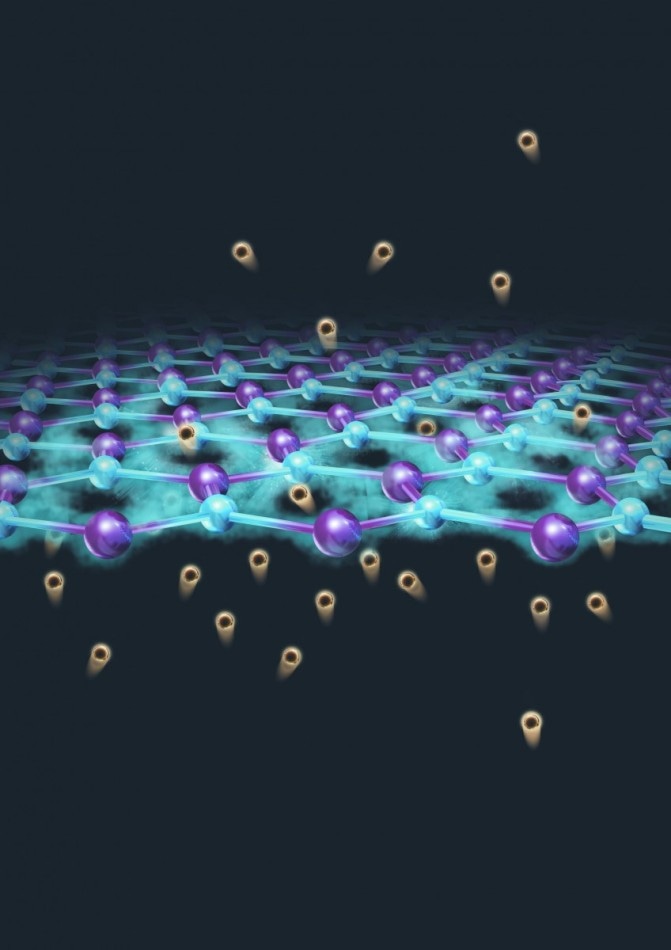Jan 24 2018
Researchers at The University of Manchester have now discovered another unexpected and new physical effect in graphene - membranes capable of being used in devices for artificially mimicking photosynthesis.
 Image credit: The University of Manchester
Image credit: The University of Manchester
The new discoveries showed an increase in the rate at which the material conducts protons when it is just illuminated with sunlight. The ‘photo-proton’ effect, as it has been labeled, could be exploited for designing devices that can directly harvest solar energy in order to generate hydrogen gas, a promising green fuel. It could also be of interest for various other applications, such as photo-catalysis, light-induced water splitting and for developing new types of greatly efficient photodetectors.
Graphene is a sheet of carbon atoms only one atom thick and has a number of unique mechanical and physical properties. It is an exceptional conductor of electrons and capable of absorbing light of all wavelengths.
Recently, researchers discovered that it is also permeable to thermal protons (the nuclei of hydrogen atoms), which means that it could be used as a proton-conducting membrane in different technology applications.
To study how light affects the behavior of protons permeating via the carbon sheet, a team headed by Dr Marcelo Lozada-Hidalgo and Professor Sir Andre Geim succeeded in fabricating pristine graphene membranes and decorating them on one side with platinum nanoparticles. The Manchester scientists were indeed shocked to discover that the proton conductivity of these membranes was improved 10 times when illuminated with sunlight.
By far the most interesting application is producing hydrogen in an artificial photosynthetic system based on these membranes.
Dr Marcelo Lozada-Hidalgo
This is essentially a new experimental system in which protons, electrons and photons are all packed together in an atomically thin volume. I am sure that there is a lot of new physics to be unearthed, and new applications will follow.
Professor Sir Andre Geim
Scientists all over the world are busy exploring how to directly make use of solar energy for producing renewable fuels (such as hydrogen) by imitating photosynthesis in plants. These man-made ‘leaves’ will need membranes with extremely refined properties – including permeability to gases, mixed proton-electron conductivity, optical transparency and mechanical robustness.
Presently, researchers use a combination of proton and electron-conducting polymers in order to produce such structures, but these need a few significant trade-offs that could be prevented by using graphene.
Using mass spectrometry and electrical measurements, the researchers explain that they were able to measure a photoresponsivity of almost 104 A/W, which translates into almost 5000 hydrogen molecules being produced in response to each solar photon (light particle) incident on the membrane. This is a large number if compared with the presently available photovoltaic devices where many thousands of photons are required for producing just one hydrogen molecule.
We knew that graphene absorbs light of all frequencies and that it is also permeable to protons, but there was no reason for us to expect that the photons absorbed by the material could enhance the permeation rate of protons through it.
The result is even more surprising when we realized that the membrane was many orders of magnitude more sensitive to light than devices that are specifically designed to be light-sensitive. Examples of such devices include commercial photodiodes or those made from novel 2D materials.
Dr Marcelo Lozada-Hidalgo
Typically, photodetectors harvest light in order to generate only electricity but graphene membranes generate both electricity and, as a by-product, hydrogen. The speed at which they react to light in the microsecond range is faster when compared to most commercial photodiodes.
The authors of this research work acknowledge support from the Lloyd’s Register Foundation, EPSRC (EP/ N010345/1), the European Research Council ARTIMATTER project (ERC-2012-ADG) and from Graphene Flagship. M.L.-H. acknowledges a Leverhulme Early Career Fellowship.